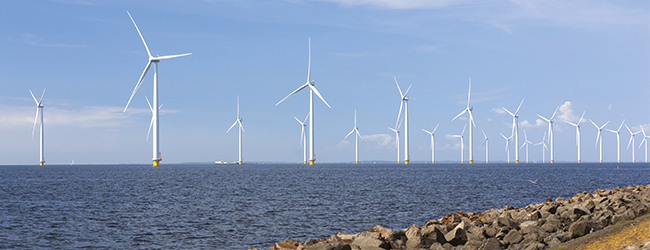The Offshore Boom – How Lubricants Can Support the Next Generation of Wind Power
In 2016, the first offshore wind farm off the coast of Block Island, Rhode Island went live. Right now, it remains the only fully operational offshore wind farm in the United States, but that is about to change. This is due in large part to a push from the federal government to increase offshore wind capacity by 30 gigawatts (GW) by 2030. In 2023, two additional offshore farms in the United States will join the grid off the coasts of Marthas Vineyard, Massachusetts and Long Island, New York. The increase in speed with which offshore wind turbines are being built speaks to the significant growth this industry is expected to see in the coming years.

A More Powerful Energy Source
The offshore wind market may be relatively new in the United States, but globally, in places like China and the United Kingdom, the market is well-established and significant innovations in wind turbine design have been made. Offshore turbines are larger, more powerful, and more efficient than their onshore counterparts. Whereas the height of an onshore turbine averages around 465 ft, the average height of offshore turbines is 600 ft with the tallest clocking in at just over 850 ft in height. For reference, that’s only two hundred feet shorter than the Eiffel Tower. Winds are stronger and more reliable at higher elevations and off the coast, enabling offshore turbines to average 1 MW more energy than onshore turbines. To put things in perspective, one single rotation from an offshore turbine collects enough energy to power a home in the UK for two days.
Engineering Hurdles
The increased size of these designs, paired with the challenging open water environment, poses new challenges for the engineers designing these turbines and their component suppliers. The offshore environment of wind turbines is inherently more corrosive due to the presence of water, salt, and humidity. Ocean waves and increased wind speed also increase vibrations and friction between components throughout the turbine. The increased size and weight of the turbine increases the load components must be able to withstand.
The location of these turbines, sometimes 25-50 miles from the coast, presents difficulties when a failure occurs, and the turbine must be serviced. Any materials that technicians may need to service the turbine must be transported by boat. Inclement weather like storms and high winds can also determine whether a turbine can be serviced at all on a given day. “Imagine commissioning a service team, a boat to get to the tower offshore, only to get there and realize it’s too dangerous to go up. Carefully selecting materials, including lubricants, in the design phase is critically important as it ensures that the turbine is serviced as little as possible,” says JJ Gonzalez, a Business Development Engineer for the wind segment at FUCHS Lubricants Co.
While the long-term benefits of offshore wind are clear, building offshore turbines costs on average 20% more than building an onshore turbine, meaning that stakeholders must reduce risk and downtime at every step in the supply chain to protect their investment.
Offshore Lubrication – Consideration Factors
To address these engineering challenges, lubrication companies must provide reliable, efficient, and sustainable solutions to keep wind turbines spinning and the power flowing. Here are a few of the factors that you should take into consideration when selecting a lubricant for offshore wind turbines:
To combat the harsh sea environment, a lubricant with superior corrosion resistance must be selected. An inert, hydrophilic lubricant that remains stable in the presence of moisture and salts should be selected.
With the increased friction and loads of wind turbine designs, lubricants with specialized anti-wear and extreme-pressure additives should be selected.
The recommended service life of a lubricant dictates how often the component will need to be serviced and relubricated. Long-life lubricants can help minimize downtime by extending time between servicing.
While nacelles aren’t small, they aren’t open spaces for technicians to work. Anything big that a technician might need as far as pumps or hoses, or containers of lubricants need to get up and down the tower somehow. All nacelles have a hoist up the equipment, normally either through the tower, or more often through a latch in the back of the nacelle. FUCHS carries lubricants in a variety of packaging sizes and types including spray cans, larger containers for auto lubers, and more.
FUCHS, your global partner for superior wind lubrication solutions
To ensure wind turbines operate efficiently and reliably with minimum-possible wear and maximum power generation, you need a partner who has both: experience and innovative strength. A one-stop shop with an in-depth understanding of the wind industry’s requirements and challenges. We not only carry grease for the main, yaw and pitch bearings but also gear oils and cleaners for every part of the tower. With a worldwide network and a global supply chain to guarantee product availability anytime, anywhere. And with highly efficient lubrication solutions help create more energy during turbine lifetime and decrease your carbon footprint and lower your cost per kWh. At FUCHS we offer all this and more. Working collaboratively, we develop high performance lubrication solutions tailored to each wind application’s precise requirements. Count on us for support, advice and a positive can-do attitude.

